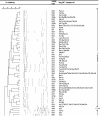Longitudinal study of the excretion patterns of thermophilic Campylobacter spp. in young pet dogs in Denmark
- PMID: 15131162
- PMCID: PMC404596
- DOI: 10.1128/JCM.42.5.2003-2012.2004
Longitudinal study of the excretion patterns of thermophilic Campylobacter spp. in young pet dogs in Denmark
Abstract
The Campylobacter excretion patterns of 26 domestic pet dogs were described in a longitudinal study. The dogs entered the study between 3 and 8 months of age and were monitored until 2 years of age. They were tested monthly for Campylobacter carriage in stool samples that were cultured on the Campylobacter-selective media CAT and modified CCDA agar at 37 and 42 degrees C. This study comprised 366 fecal swab samples, of which 278 (76.2%) were found to be Campylobacter positive, with the following distribution of species: 75.0% Campylobacter upsaliensis, 19.4% Campylobacter jejuni, 2.1% Campylobacter lari, 0.7% Campylobacter coli, and 2.8% Campylobacter spp. Isolates were typed by pulsed-field gel electrophoresis (PFGE) to elucidate the strain excretion pattern. All study dogs excreted Campylobacter spp. during the study period. At 3 months of age, 60% of the dogs carried Campylobacter, increasing to nearly 100% carriers at 1 year of age, whereafter the carriage rate decreased to 67% at 24 months of age. The PFGE types showed that individual dogs were often colonized by unique strains of C. upsaliensis for several months, up to 21 months or longer. These C. upsaliensis strains were either clonal (or underwent concurrent minor mutative changes) or independent strains. In contrast, the excreted C. jejuni isolates were much more diverse and, in most cases, only seen in one sample from each dog. A high degree of diversity among different dogs was seen. We conclude that young domestic pet dogs excreted Campylobacter spp. during the majority of their puppyhood and adolescent period. In general C. upsaliensis strains were excreted for months, with short-term interruptions by or cocolonization with other transitory Campylobacter spp., predominantly C. jejuni. C. jejuni was more prevalent in dogs between 3 months and 1 year of age than in dogs between 1 and 2 years of age.
Figures






References
-
- Anonymous. 1990. Nordic Committé on Food Analysis, 2nd ed. Methodic no. 119: Campylobacter jejuni/coli detection in foods. Statens Tekniska Forskningscentral, Esbo, Finland.
-
- Anonymous. 1993. Microbiology—general guidance on methods for the detection of Salmonella (ISO 6579, 3rd ed.). International Organization for Standardization, Geneva, Switzerland.
-
- Baker, J., M. D. Barton, and J. Lanser. 1999. Campylobacter species in cats and dogs in South Australia. Aust. Vet. J. 77:662-666. - PubMed
-
- Burnens, A. P., B. Angeloz-Wick, and J. Nicolet. 1992. Comparison of Campylobacter carriage rates in diarrheic and healthy pet animals. J. Vet. Med. 39:175-180. - PubMed
Publication types
MeSH terms
Substances
LinkOut - more resources
Full Text Sources
Miscellaneous

